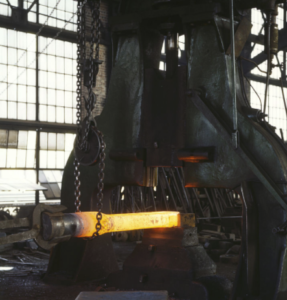 Forging has been around for centuries and the 19th century marked an important turning point leading into modern day techniques that are still being used today. James Hall Nasmyth is credited for the invention of the steam hammer with his patent in June 1842 which began a new era for forging.
Forging has been around for centuries and the 19th century marked an important turning point leading into modern day techniques that are still being used today. James Hall Nasmyth is credited for the invention of the steam hammer with his patent in June 1842 which began a new era for forging.
Steam Hammers
A steam hammer uses high-pressure steam to rise and power the ram to strike the part being forged. Several, perhaps many blows, are used for the parts to achieve the proper dimensions and metallurgical properties required by the customer.
Mechanical and Hydraulic Forging Hammers
Other closed-die forging processes include mechanical and hydraulic presses. Mechanical presses are found when forging small parts in high volume. Hydraulic presses, including hydraulic screw presses, can be used with all types of materials, but have found growing usage in the super-alloy markets primarily for the aerospace market.
Automated Forging Process
Many forging processes can now be automated with computers, streamlining the process and making for quick and precise parts for industries like aerospace and transportation. A process that was developed thousands of years ago, forging remains one of the most effective ways to produce metal parts for critical applications.
